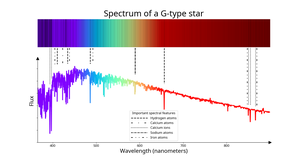Glossary term: G-type Star
Description: A star with spectral type "G". Astronomers identify G-type stars by the presence of strong absorption lines from ionized calcium; more generally, absorption lines from metals are stronger in G-type stars than in hotter stars (such as F-type stars) and weaker than in cooler stars (such as K-type stars). G-type stars have typical (effective) temperatures between around 5200 kelvins (K) and 6000 K. Compared to other stars, they appear yellow to human eyes, unless interstellar or atmospheric reddening is important. G-type stars that are main sequence stars, that is, that are burning hydrogen to helium in their core region with nuclear fusion, are called yellow dwarfs. The Sun is an example of a G-type star that is a yellow dwarf.
Related Terms:
See this term in other languages
Term and definition status: This term and its definition have been approved by a research astronomer and a teacher
The OAE Multilingual Glossary is a project of the IAU Office of Astronomy for Education (OAE) in collaboration with the IAU Office of Astronomy Outreach (OAO). The terms and definitions were chosen, written and reviewed by a collective effort from the OAE, the OAE Centers and Nodes, the OAE National Astronomy Education Coordinators (NAECs) and other volunteers. You can find a full list of credits here. All glossary terms and their definitions are released under a Creative Commons CC BY-4.0 license and should be credited to "IAU OAE".
If you notice a factual error in this glossary definition then please get in touch.
Related Diagrams
Spectrum of a G-type star
Credit: IAU OAE/SDSS/Niall Deacon
License: CC-BY-4.0 Creative Commons Attribution 4.0 International (CC BY 4.0) icons









